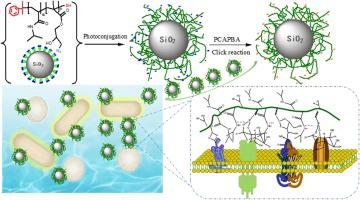Colloids and Surfaces B: Biointerfaces ( IF 5.4 ) Pub Date : 2020-11-04 , DOI: 10.1016/j.colsurfb.2020.111433 Hongwei Zheng 1 , Haiyue Gong 2 , Limin Cao 3 , Hong Lin 3 , Lei Ye 2

|
A new photoconjugation approach was developed to prepare nanoparticle-supported boronic acid polymer for effective separation and enrichment of bacteria. The photo-activated polymer immobilization was demonstrated by coupling an azide-modified copolymer of N-isopropylacrylamide and glycidyl methacrylate to a perfluorophenyl azide-modified silica surface. The thermoresponsive polymer was synthesized using reversible addition fragmentation chain transfer polymerization followed by conversion of the pendant epoxides into azide groups. The perfluorophenyl azide-modified silica nanoparticles were synthesized by an amidation reaction between amino-functionalized silica and pentafluorobenzoyl chloride, and a subsequent treatment with sodium azide. Bacteria-capturing boronic acid was conjugated to the silica-supported polymer chains via Cu(I)-catalyzed azide-alkyne cycloaddition (CuAAC) click reaction. The particle size, morphology and organic content of the composite nanoparticles were characterized systematically. The capability of the nanocomposite to bind Gram-positive and Gram-negative bacteria was investigated. The nanocomposite exhibited high binding capacities for E. coli (13.4 × 107 CFU/mg) and S. epidermidis (7.66 × 107 CFU/mg) in phosphate buffered saline. The new photoconjugation strategy enables fast and straightforward grafting of functional polymers on surface, which opens many new opportunities for designing functional materials for bioseparation and biosensing.
中文翻译:

温度和pH响应聚合物与二氧化硅纳米粒子的光共轭,用于细菌的分离和富集
开发了一种新的光结合方法,以制备纳米颗粒负载的硼酸聚合物,以有效分离和富集细菌。通过将N-异丙基丙烯酰胺和甲基丙烯酸缩水甘油酯的叠氮化物改性的共聚物偶联到全氟苯基叠氮化物改性的二氧化硅表面上,证明了光活化聚合物的固定化。使用可逆的加成断裂链转移聚合反应,然后将侧挂的环氧化物转化为叠氮化物基团来合成热响应性聚合物。通过氨基官能化的二氧化硅和五氟苯甲酰氯之间的酰胺化反应,然后用叠氮化钠处理,来合成全氟苯基叠氮化物改性的二氧化硅纳米粒子。捕获细菌的硼酸与二氧化硅负载的聚合物链共轭通过Cu(I)催化的叠氮化物-炔烃环加成反应(CuAAC)单击反应。系统地表征了复合纳米粒子的粒径,形态和有机物含量。研究了纳米复合材料结合革兰氏阳性和革兰氏阴性细菌的能力。该纳米复合材料在磷酸盐缓冲液中对大肠杆菌(13.4×10 7 CFU / mg)和表皮葡萄球菌(7.66×10 7 CFU / mg)具有高结合能力。新的光结合策略可以在表面上快速直接地接枝功能聚合物,这为设计用于生物分离和生物传感的功能材料打开了许多新机会。









































 京公网安备 11010802027423号
京公网安备 11010802027423号